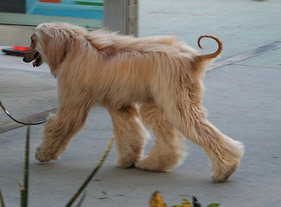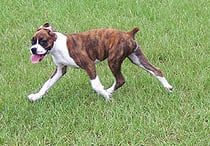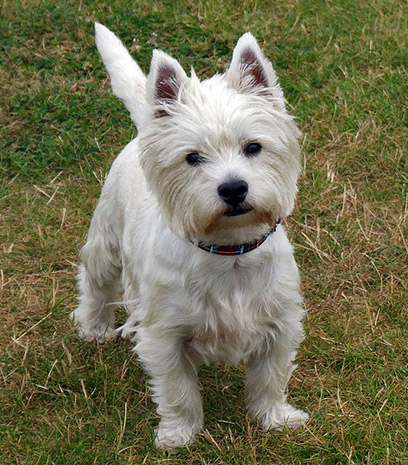Breed Characteristics for the AKC Dog Groups
Dog Breed Groups
Whether you want a purebred or a mix breed, knowing the breed characteristics can help you find the right dog for you because even with mix breeds, you can usually guess at least one or two of the breeds in a the dog's ancestry. A dog's breed makeup influences not only his appearance but also his personality and aptitudes.
The 150 or so breeds that are recognized by the American Kennel Club are divided into 7 broad groups that include sporting, hound, working, terrier, toy, herding, and non-sporting, which is a catch-all group for dogs that don't fit into the other categories. Because the dogs in each group (except non-sporting) were bred for a certain purpose, they usually share such general traits as energy level, tendency toward aggression, and trainability, as outlined below.


Sporting Dogs
The Sporting Groups contains dogs that were bred to help hunters in the field by finding, flushing, and/or retrieving game, primarily birds. Depending on the bred and whether the dog receives proper care, Sporting Dogs have an average life of 10 to 16 years.
Common Traits:
Because these dogs were originally bred to hunt, they are high-energy dogs with a strong retrieving instinct. They are usually active, friendly, and alert.
Training Issues:
Without plenty of exercise and mental stimulation, Sporting Dogs can become bored and very destructive.
Common Breeds:
Brittany: Brittanys are relatively small, highly active dogs that prefer to hunt closely with people. Brittanys have a strong desire to please, but they require a good deal of patience in training. Sometimes prone to excessive barking, hyperactivity, and destructive chewing if they are properly trained and exercised.
Golden Retriever: One of the most popular breeds of all time, Goldens are loving, social, family- oriented dogs that love to spend time with people in any capacity.
Labrador: Labs are often referred to as the clowns of the Sporting Group, due mainly to a generally cheerful outlook and friendly nature. Eager to please, Labs are well-known as service dogs for the blind and physically challenged.
Irish Setter: Known for a beautiful, coppery red coat and graceful carriage, it is sometimes hard to remember that Irish Setters are more than a pretty face. They were originally bred to be gun dogs, and to this day they continue to demonstrate excellent field manners when properly trained.
Cocker Spaniel: The smallest member of the Sporting Group, the Cocker (or American Cocker) is known for a beautiful coat. Most cockers are affectionate and readily trainable.



Hound Dogs
The Hound Group contains dogs that seek and follow prey by either sight or scent. Hounds can be quite driven to hunt, and may focus exclusively on what their noses or eyes are telling them rather than paying attention to their pet parent. These dogs were bred to track game in the field. Depending on the bred and whether the dog receives proper care, Hound Dogs have an average life of 10 to 16 years.
Common Traits:
These dogs are hardy and brave. Because Hounds were bred to track prey and work independently, they tend to be very independent dogs.
Training Issues:
Hounds can be stubborn and hard to train. They are driven by tracking instinct, which means that they are prone to roaming when let off the leash. You must have good fences to keep Hounds from running off once they've gotten the scent and have focused on something. Some have a loud, baying, bark that can be annoying.
Common Breeds:
Afghan Hound: Often called the "cover girl" of the dog world, Afghans are known for their long, flowing locks and regal carriage. These large dogs require daily exercise.
Beagle: Often thought of as the ultimate pet for a young boy, thanks to a certain popular comic strip, Beagles are known for their excellent nose and are often trained as detection dogs. They can sometimes be prone to excessive barking and digging, so training is essential.
Bloodhound: Frequently used for tracking in police work, Bloodhounds were named for the phrase "blood hound," because of the great care taken in the 12th century to keep the strain pure. They must always be walked on leash.
Foxhound: This is one of the few breeds not actually bred to be a companion to people. Foxhounds do best in packs, and require serious exercise.
Greyhound: Often called "the 40-mile-an-hour couch potato," Greyhounds are known racing dogs. They can make wonderful, loving pets with surprisingly moderate exercise requirements.
Dachshund: The smallest of the Hound Group, the Dachshund may well be one of the bravest. Originally bred to beard badgers in their den (to chase and trap them), Doxies don't tend to back down easily. To keep a Dachshund happy and healthy, provide consistent, loving training and activity that does not place extra strain on their long backs.



Working Dogs
The Working Group is made up of dogs bred to work with people in such diverse areas as policing, guard, pulling carts, protection, pulling sleds, and water rescue. Depending on the breed and whether the dog receives proper care, Working Dogs have an average life of 6 to 10 years.
Common Traits:
Working Dogs were developed to work as a member of a team, whether it is on a team of sled dogs or on a team with people. Well-bred, well-socialized, working dogs make wonderful, if quite large, companions. They are very intelligent and strong-willed dogs.
Training Issues:
Working dogs require early socialization, high quality training, consistent exercise, and a dependable routine. They are large and strong, and they can be aggressive and territorial.
Common Breeds:
Boxer: Intelligent, fearless, agile, and strong, the Boxer is so named for his tendency to paw at (or "box") an opponent. They are loyal and loving companions and make excellent watchdogs.
Great Dane: One of the tallest dog breeds, Great Danes are often called "gentle giants." While originally bred for hunting wild boar in Europe, they are loyal, gentle companions. Unfortunately, all giant breeds tend to have shorter life spans than average- sized breeds.
Newfoundland: Bred for water work, Newfoundlands are true working dogs. From water rescue to draft work (pulling carts) to helping sailors with heavy nets, "Newfies" are happiest when given a job alongside their favorite person. They love the water and even have webbing between their toes to aid in swimming.
Rottweiler: Originally bred as a "drover" (a herder of large animals over long distances), they are known for police and soldier work. Social animals, "Rotties" are true joys to be around.
Siberian Husky: Known as Nordic sled dogs, Huskies were imported to Alaska in the early 1900s. They were developed by the Chukchi people of northeastern Asia to pull light loads to keep mentally and physically healthy. Good fences are needed to keep them safe.



Terrier Dogs
The Terrier Group contains dogs that were bred to "go to ground," following their prey. They were originally bred to hunt and kill rats and other vermin. Terriers are known for their high energy and independent, cheerful attitudes. Depending on the breed and whether the dog receives proper care, Terriers have an average life of 10 to 16 years.
Common Traits:
Terriers will have a variety of common traits to include scrappy, self-confident, and relentless.
Training Issues:
Terriers were developed to work independently and can therefore sometimes be more challenging to train than other breeds. Generally, they need some form of mental stimulation such as hunting, tracking, agility, flyball, etc. Good fences and leashes are a must. They tend to be quite stubborn and focused, which can make them hard to train. Some breeds were originally bred to fight to the death, so some rarely back down even when their owners want them to.
Common Breeds:
Airedale: The largest of the Terrier Group, Airedales are known today for police, protection, and soldier work. With consistent and patient training, they make wonderful pets.
Cairn Terrier: A small dog originally bred to get foxes, otters, and other pests to "bolt" from the rocks and cliffs of Scotland, the Cairn terrier is best known as Toto, Dorothy's friend in the Land of Oz.
Scottish Terrier: Although, the breed standard allows several different coat colors, most people expect Scotties to be a deep jet black with alert ears and jaunty disposition.
Miniature Schnauzer: Derived from the Standard Schnauzer of the Working Group, Miniature Schnauzers are well-known for their hardiness and intelligence. They can be difficult to train, but patience and persistence will produce a wonderful, loyal companion.
Soft Coated Wheaten Terrier: Usually called "Wheatens," this terrier is known for a soft and silky coat that is the color of wheat. These loving, exuberant companions require consistent and patient training to be at their best.
West Highland White Terrier: Spunky, determined and devoted, Westies are popular due to their small size, hardiness, and snow white coat. They need frequent exercise, patient training, and also require a good amount of grooming, including daily brushing.



Toy Dogs
The Toy Group contains dogs that have been bred down in size to become perfect companions and watch dogs. Although small in stature, toys are definitely not short on love or courage. Depending on the breed and whether the dog receives proper care, Toys have an average life of 10 to 16 years or more.
Common Traits:
These dogs are typically small and affectionate. Their legs tend to be more delicate than those of their full-sized cousins. They are generally not recommended for young children or serious roughhousing.
Training Issues:
Developed as companions, lapdogs, and watchdogs, they may be rather vocal. Training and mental exercise to prevent boredom may help with excessive barking.
Common Breeds:
Maltese: With flowing white hair, jet-black nose and eyes, and a merry disposition, Maltese have been kept as pets for 28 centuries. Well-bred Maltese are healthy, spirited, and wonderful companions.
Pekingese: Originally held sacred in China, the Pekingese date back to at least the 8th century. They are known for their dignity and even downright stubbornness.
Pomeranian: Sometimes called "puffballs with feet," Poms are the descendants of sled dogs of Iceland, Lapland, that were used as sheepherders before being bred down to their current size.
Shih Tzu: The product of crossing the Lhasa Apso with the Pekinges, Shih Tzu means "lion dogs." They are lively, very active, independent, and the most outgoing of the Asian breeds.
Toy Poodle: Often considered the classic Toy dog, Toy Poodles share all the characteristics of their larger cousins, packaged in an often pocket-sized bundle. They are intelligent, loyal, and do best if given training that challenges and showcases their mental talents.
Yorkshire Terrier: Although a Toy in size, the Yorkie is all terrier when it comes to personality. Stubborn and possessive, Yorkies can prove a challenge to housebreak and train, but persistence, patience, and positive reinforcement will win out in the end.



Herding Dogs
The Herding Group contains dogs that were bred to use their natural prey drive to herd everything from sheep and goats to cattle and horses. Like the Working and Sporting dogs, they were developed for specific jobs and need mental exercise along with the physical to stay healthy. Depending on the breed and whether the dog receives proper care, Herding dogs have an average life of 10 to 16 years.
Common Traits:
Herding dogs were developed to work independently or in close partnership with people and are typically intelligent, alert, and energetic
Training Issues:
These dogs need daily aerobic exercise, consistent training, and mental stimulation such as tracking, agility, flyball, etc. They generally excel in training, police work, and herding competitions. Without plenty of exercise and stimulation, herding dogs may become bored and destructive. They are prone to chasing and barking at children in an attempts to herd them.
Common Breeds:
Australian Cattle Dog: Also known as Blue (or Red) Heelers, these dogs were developed in Australia to herd shep and cattle long distances. Their nickname, "Heeler," refers to their herding style of nipping cattle and sheep on their heels.
Collie: The beloved "Lassie" collies are known worldwide for beautiful coats, sunny dispositions, and extreme intelligence. Well-bred Collies excel in the training rind and in family homes. They come in long-coated (or rough) and short-coated (or smooth) versions.
German Shepherd Dog: The epitome of the police or military dog, known for being rugged, intelligent, and loyal.
Old English Sheepdog: The clowns of the dog world, "Bobtails" are merry, playful balls of extensive fur that love people, play, and water; they require a definite training commitment. Their heavy, thick coat requires serious grooming.
Shetland Sheepdog: Has a collie's beauty, brains, and loyalty, but is one-third the size and is known for being vocal. Shelties require the same grooming and training commitments as their lager look-a-likes.
Welsh Corgi: Strong and brave enough to herd the largest stock, the Corgi is also low-slung and smart. Corgis come in two varieties: the Cardigan and the Pembroke. The most obvious difference lies in the tail- Cardigans have one and Pembrokes do not.








